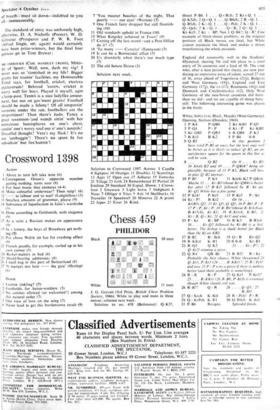Chess 459
PHILIDOR
J. G. Grevatt (3rd Prize, British Chess Problem Society, 1966). White to play and mate in three moves; solution next week.
Solution to no. 458 (Bettmann): Q-K3!,
threat P-B4. 1 . . . Qx Rch; 2 Kt x Q. 1 . . .
Q-KSch; 2 Q x Q. 1 Q-B4ch; 2 R x Q. 1 . . . Q-B5ch; 2 KxQ. 1 . . . Q x Pch; 2 KxQ. 1 . . . QxQch; 2 KxQ. 1 ...QxB; 2 QxQ. 1 ... Kt-Kt3; 2 Kt x BP. Not 1 Q-B4?, Qx R! Fine example of block-threat problem; in the original position all Black moves are fatal, but White cannot maintain the block and makes a threat transforming the whole position.
England did reasonably well in the Students' Olympiad, sharing 5th and 6th place in a total entry of 26 countries and a final of 10. The USSR who, after a lean period (for them), are now pro- ducing an impressive array of talent, scored 27 out of 36, away ahead of Yugoslavia (214), Bulgaria and West Germany (194), England and East Germany (174), the us (17), Roumania (164) and Denmark and Czechoslovakia (12). Only West Germany of the non-Soviet countries did bette. than we did—and we are capable of doing bette still. The following interesting game was playeu in the finals.
White, Soltis (us). Black, Maeder (West Germany). Opening, Sicilian (Dresden, 1969).
1 P-K4 P-QB4 2 Kt-KB3 P-Q3 3 P-Q4 P x P 4 Kt x P Kt-KB3 5 Kt-QB3 P-QR3 6 B-QB4 P-K3 7 B-Kt3 B-K2 8 P-B4 0-0
9 Q-B3 . In this position 1
have tried P-B5 at once, but the text may well be better as it is likely to induce Q-B2, an un- satisfactory square for the queen in this line as will be seen.
Q-B2 Or 9 . . , Kt-133; 10 Kt(4)-K2 and 10 . . . P-Q1a4? being un- playable, because of II P-KS, Black will hart to play Q-B2 anyway.
10 P-B5 P-K4 11 Kt(4)-K2 P-QKt4 Maybe 11 . . . Kt-B3 (threat Ki-QR4) is better. but after 12 B-Kt5 followed by B x Kt an Kt-Q5 White has a fine game.
12 P-Kt4! P-Kt5 13 P-Kt5 P x Kt
14 Kt x P! B-Kt2 Or 14 ... Kt(B3)-Q2; 15 Kt-Q5, Q-Q1; 16 P-B6!, P' P 17 Px P, Kt x P; 18 B-R6! (threat R-Ktich atr B-Kt7ch), Kt-K1; 19 R-Kt !ch. K-RI; 21 Kt x B, Qx Kt; 21 Q-K13! and wins.
15 P x Kt Bx BP 16 B-K3 B-RSch
16 . . . Kt-Q2 followed by Kt-B4 is a hill better. The bishop is a shade better for BlacA than the Kt on KB3.
17 B-B2 Bx Bch 18 QxB Kt-Q2
19 R-KKtl K-RI 20 0-0-0 Kt-B3 21 R-Q3 Q-K2 21 . . . Kt xP?: 22 Q-K121 winning a piece.
22 Q-R4 QR-B1 23 R-R3! R x Kt Probably the best chance. White threatened 24 Q-105, P-Kt3 (24 . . . R-K1(11 ?; 25 R x Pclt! and now 25 P x P wins a pawn if there is nothing better (and there probably is something).
24 R R Bx P 25 Q-Kt5 P-Kt3? 25 . . . R-1001 (26 R-B8, P-Kt3) is essential. though White should still win.
26 R-B7! Qx R 26 . . . Q-Q1; 27 R-B8!
27 Q x Ktch .K-Ktl 28 R x Pch! P x R 29 Qx KtPch K-RI 30 Q-R6ch K-Ktl Splendid finish. 31 P-B6 Resigns.


































 Previous page
Previous page